There are an estimated 2 million species of animals on our planet. 1.3 million (65%) are invertebrates – animals that lack backbones – 1 million (50%) are insects. These animals cover all parts of the Earth. From the coldest mountain tops of Antarctica to the darkest depths of the ocean. There are still many species to be discovered and classified. And there in lies problem number one – how do you classify 1.3 million different types of creatures into groups?
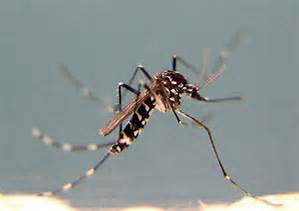
Photo: UF IFAS
Well, we begin with the Kingdom Animalia. We defined animal in Lesson 3 of Life Forms last month. So, that part is done. All invertebrates are animals.
Next is phylum.
How do we do that?
Well, our predecessors have helped lay that road. While many biologists today focus on genetics and biochemistry, our predecessors focused on form and behavior. Helping us with “who are these creatures and how should they be classified?”
The first thing we look at is their symmetry – how are their bodies laid out. In this case we can quickly divided all of the invertebrates into two groups – radial and bilateral.
When looking at an animal you can tell where the head and tail ends are. You can also tell where the top and the bottom are. The head end is known as the anterior end. The tail posterior. The top is dorsal, and the bottom is ventral.
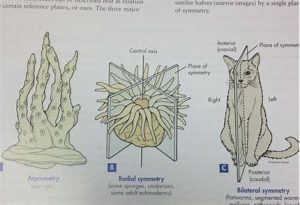
Image: Study Blue project
Having all four of these would make you bilateral. The term bilateral is because the animal is laid out with two equal halves placed together. Looking at you, you have your head – and eye and ear on each side. Your nose has a nostril on each side. As you move down your body you have an arm, and hands, as well as legs on each side. I can tell where your head is, as well as your tail end, the top and bottom of your body. Think of your dog, it is the same.
Radial symmetry lacks a distinct anterior and posterior end. I can tell where the top is but not the head. Take the starfish for example. I can tell whether it is upside down or not, but I cannot tell where the front is. So, this is step one in classifying 1.3 million species… are you radial or bilaterally symmetrical.
The next is the presence or absence of an internal body cavity. All animals have an exterior skin layer. Most also have an opening (the mouth) that leads to an internal cavity (the gut). But for some, the layer between the internal gut and the exterior skin may, or may not, have a cavity. A coelom. If you do have an internal cavity you are called a coelomate. If not, you are called an acoelomate. Being a coelomate will allow for the development of internal organs (kidneys, heart, brain) and allow the body to grow to larger size and function at a higher level. You are a coelomate.

Image: Study Blue project
So, we can further classify animals into phyla based on whether you are radial or bilateral, and whether you are a coelomate or acoelomate. It is believed that the radial/acoelomate form is the most primitive and the bilateral/coelomate more advanced. All vertebrates are bilateral/coelomates, and most invertebrates are – but not all. Let’s look at one.
The Cnidarians
First, it is pronounced (Ni – dairy -n) – the “C” is silent. These are not the simplest animals on the planet, the sponges are, but they are next in line. They are more commonly known as “jellyfish” and are radial/acoelomates. The “jelly” portion of their body is a solid layer of noncell fibrous material called mesoglea. There is no coelomic cavity between the gut and skin, so no formal internal organs. Though many cnidarians can get rather large, their form and function are pretty simple. It is only because they live in water that they can even get large; they do not have a skeleton to support them out of water.

Photo: University of California
Of course, they are radial. There is the top of the jellyfish (“the tops don’t sting” – from Finding Nemo) and there is a bottom (ventral side). On the ventral side you will find a mouth, with no teeth. This mouth leads to a simple gut, where digestion takes place. The digested material is absorbed by the animal with no heart or blood vessels. And there is not an opening to go to the bathroom, so the cnidarians must expel their waste back out of the mouth – not cool.
So, what – how – do they eat?
Cnidarians are carnivores – they eat other animals. To do this they must first find them. Some jellies float in the open water, pulsating their bell using a flap of skin called the velum. This slow pulsation can move them forward, but not very fast. They do not have eyes or senses as we do – they do not have a brain to process that information. But they are aware of their environment. Some have cells that can detect light, which either they like or hate and moves towards or away. There is a series of cells called statocysts that will let them know their orientation in the water – whether they are upside down or not. And they seem to have a sense of smell or taste. Some jellies can sense prey to their left and move in that direction. All that said, they cannot swim against an ocean current or tide, so they are more drifters (plankton) than true swimmers (nekton). These large swimming bells are known as medusa.
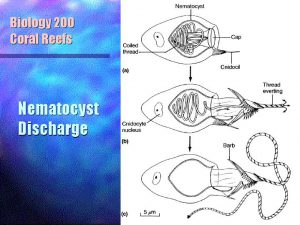
Image: University of Hawaii
So, what do they do when they encounter potential prey? How do they catch and eat them?
Cnidarians possess long, stringy, tentacles that extend from the margins of their bells. These hang in the water column, sometimes for several feet, and possess specialized cells called cnidocytes, where they get their phylum name Cnidaria. These cells are round, or oval, and have a nucleus close to the base, near the body. Encapsulated within are special organelles called nematocyst. The nematocyst is an oval organelle with a coiled thread-like harpoon all encased (coiled) within the cnidocyte. Though cnidarians do not have a brain and senses as we do, they do have a nerve net extending through their body. When they are stimulated by either contact with the prey, or smell, they can discharge the nematocyst from the cnidocyte. The thread-like structure from the nematocyst explodes from the cnidocyte into the flesh of the prey. The nematocyst has spines to hold on and a drop of toxic venom to help kill. Most cnidocytes have a stiff trigger structure facing the environment. If something touches it, it will “fire” the nematocyst and the nerve impulse can trigger the firing of nearby nematocysts injecting hundreds of venom drops into the prey. Once paralyzed, or dead, the prey can be moved to the mouth using the tentacles and feeding can begin.
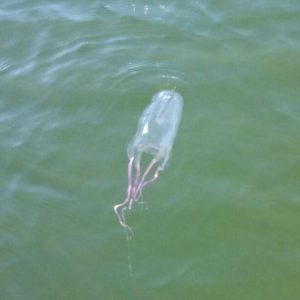
Photo: Brad Peterman
What a jellyfish can kill and eat is determined by how toxic its venom is, and some of the jellyfish are very toxic. The box jelly (Chironex fleckeri) – https://oceanservice.noaa.gov/facts/box-jellyfish.html – is considered by many to be one of the more toxic medusa jellyfish in the world. Many consider the most toxic animal in the ocean. Box jellies can be found in all warm oceans, including the Gulf of Mexico, but the deadly forms are found in the Indo-Pacific region. Even though this species has a venom that can kill humans, they typically feed on small fish and shrimp. Another cool thing about them – they can swim fast and see their prey. This very unusually for a simple jellyfish – and kind of scary – makes you want to go to Australia see one doesn’t it? Or… maybe not.
The most toxic one in our local waters near Pensacola would be the Portuguese Man-of-War (Physalia physalis) – https://oceanservice.noaa.gov/facts/portuguese-man-o-war.html. However, these are not medusa jellyfish. So, lets learn more about the other group of jellies.

Photo: NOAA
Some cnidarians hunt and feed in a different way. They do not float in the water, pulsating their velum, seeking prey. But rather they are attached to the bottom, extending their tentacles up into the water column, looking more like flowers. These are called polyps. Some are very small, almost microscopic (some species of Hydra) and others are quite large, like some species of sea anemones. Their mouths face up and the tentacles, grabbing prey floating by, pull their food into the mouth. These polyps do have stinging nematocyst, but their toxins are designed to kill much smaller prey. Some, like the corals, feed on plankton.
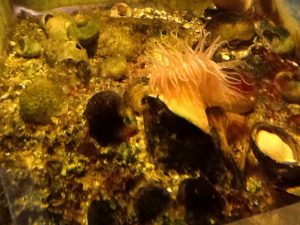
Some polyps can dislodge from the bottom and float to new locations for feeding. Others, like the corals, are cemented to the ground and each other and cannot move anywhere else. As you all know, corals can cement to each other forming large coral reefs. The Great Barrier Reef off Australia can actually be seen from space! One of the largest structures built by a creature from planet Earth.
Believe it or not, the Portuguese Man-of-War is a drifting colony of polyps! Instead of being stuck to the bottom, hundreds of polyps are connected together in long strings we call their tentacles. They produce this large gas filled bag that is exposed above the ocean surface. The wind pushes them around searching for food – basically “sailing”. The tentacles (again, long strings of hundreds of polyps) can hang down for many feet into the water. Their toxin is quite powerful and can kill relatively large fish. Once killed, the small tentacles of each individual polyp help pull the prey towards their mouths. Their guts are connected so that all members of the colony can get food from the fish that may have been killed by another group of the colony. These are AMAZING creatures, and quite toxic. Though deaths from the creature are extremely rare, you should stay clear of them – they are quite painful.
Now we know how they hunt and feed. How do they defend themselves?
As you might guess, they rarely do. Most marine creatures will not fool with a toxic jellyfish. Scientists have watched groupers give sea anemones plenty of space on the reef. But there are jelly-eaters. Sea turtles for one are famous for doing this. There is a floating sea slug called Glaucus that actually approaches the Portuguese man-of-war – consumes the polyps and their nematocyst WITHOUT FIRING THEM – and positions the nematocyst in THEIR skin making THEM toxic! Pretty cool.
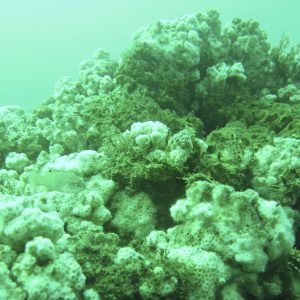
Photo: Virginia Sea Grant
Corals have a weak toxin and so need additional help. They have a live-in partner, a microscopic algae called Zooxanthellae that provides needed materials to build a calcium carbonate shell within which both live. Being algae, the Zooxanthellae require sunlight and nutrients. The sun comes from the fact they only grow in clear warm waters, and the nutrients come from the coral polyps.
How do jellyfish reproduce baby jellyfish?
Many of the polyps reproduce by an asexual method known as budding. Like some plants, small “buds” will grow from the existing animal that resemble miniature versions of the adults. These break off and form new individuals – wa-lah!
Sexual reproduction involves the production of sperm (males) and eggs (females). With jellyfish, many can produce both sperm and egg (hermaphrodites). Fertilization of the sperm and egg will occur externally. The jellyfish release their sperm/egg (gametes) into the water column where HOPEFULLY they will find each other. To increase the chance of gamete encounter – many jellyfish will mass spawn, releasing millions of gametes into the water column at the same time. These are usually triggered by environmental factors (water temperature, tides, or some combination). Corals are famous for this.
Some of the fertilized medusa gametes actually grow to be polyps – stuck to the ocean floor – and then form and release baby medusa that swim away.
We will end with one group of jellies that is very different. So different that are not in the same phylum. They are not Cnidarians but rather in a phylum called Ctenophora (pronounced T-nof-o-rans – the “C” is again silent).
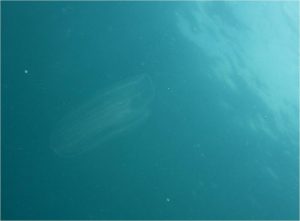
Photo: Sea Grant Collier County
Ctenophores are often called comb jellies because of the presence of rows of small fiber-hair like structures called ctenes (pronounced T-n’s). They move in a pattern similar to the bristles of a comb when you run your finger down it – hence the name “comb jellies”. They may or may not possess tentacles – many in our part of the Gulf do not – but they all lack cnidocytes and nematocyst – they cannot sting you. Rather their tentacles (if they have them) have colloblasts which grab their prey using a type of stick glue-like material. With these that can feed on plankton in the water and each other – they are cannibals.
So, how do they defend themselves.
They have two plans here. One, they reproduce like crazy – you just can’t eat them all. Two, they are bioluminescent. This means they have the ability to produce a cool-blue light at night. It is not quite understood how this would protect them. Maybe the flash of light confuses the predator? But they only do produce the light (which require oxygen and energy from the comb jelly) when disturbed. Then there is the problem with defending yourself during daylight hours.
Cnidarians and Ctenophores – “jellyfish” – are fascinating animals and have lived on this planet in their primitive form for a very long time.
ACTIVITIES
It is hard to come up with activities to do at home for cnidarians. But here are a few ideas.
- Research, look up and read about the box jellyfish. I think you will find them fascinating.
- Find a video online of the mass spawning of corals. I think you will find this fascinating as well.
- It is cold this time of year (February as I am writing this) but when the waters warm, visiting the beach and looking for these jellies would be fun. NOTE: DEAD JELLYFISH STILL HAVE NEMATOCYST THAT MAY NOT HAVE FIRED. THOUGH DEAD, AND NERVES NO LONGER FUNCTION, REMEMBER THERE IS A TRIGGER ON THE CNIDOCYTE THAT CAN STILL FIRE THEM. YOU COULD BE STUNG BY A DEAD JELLYFISH.
- Visit a local aquarium or pet store, where you can see and observe corals, anemones, and other jellies.
 0
0
